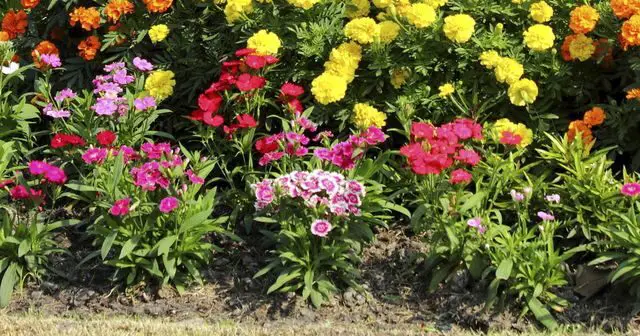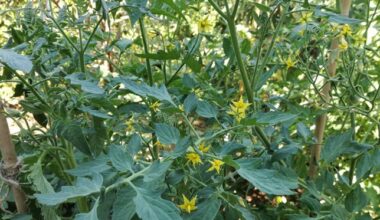Annuals, biennials, perennials, the flowers parent the gardens of multiple colors. But which ones to grow, whether in a bed, a pot, a tub or a window box, according to their flowering period? Here is a list of flowering plants, with many tips for sowing, cultivating and maintaining them.
Contents
1. The Saintpaulia
Timeless, the small saintpaulia with its velvety leaves and pastel-colored flowers has always been an interior decoration. It blooms without respite over a very long period if exposed to a rather bright light. A fresh soil and some fertilizer will be enough to keep it shining for many months.
2. The spathiphyllum
The spathiphyllum is one of those puncture-proof plants that bloom without too much care. If you buy it in miniature version, you will be surprised by its rapid growth. Its very ornamental glossy green foliage and its original white inflorescences make it a plant of first choice.
3. The cleavia
Who hasn’t known the famous pot of clivia at his grandmother’s! Well this plant makes its return in force proud of its sumptuous orange bouquets and its brilliant foliage. The clivia tolerates a cool wintering (between 5 and 8°C), and some forgetfulness of watering during this period, it will bloom even better.
4. The Christmas cactus
It brightens up the house around Christmas time with its white, fuschia pink, orange or red flowers. In the meantime, the Christmas cactus will only require a temperature above 13° and a little light to stay in shape. After the bloom respect a period of rest with very moderate watering.
5. Cyclamen
There are many varieties of cyclamen, you are bound to find one to your taste. This plant is ideal for apartments with little heating, or to decorate a winter garden. Watering should be regular only during flowering, then a period of dry rest should be respected during the beautiful season.
6. The phalaenopsis
Very easy to grow, the butterfly orchid requires much less care than one might think. A weekly bathing in water at room temperature, a light exposure without direct sunlight and that’s it!
7. The Kalanchoe
The Blossfeld Kalanchoe is a very easy succulent plant that requires only light and a few waterings to bloom abundantly in bright tones. It tolerates a beautiful range of temperatures between 10°C and 30°C. It tolerates without concern some forgetfulness at the level of watering.
8. The Amaryllis
Plant with the giant bulb, it can be cultivated in special vase or pot. Its solid floral stem supports spectacular and colorful flowers sometimes even variegated. Once the bloom finished let simply dry the foliage and keep the bulb of the amaryllis dry until the following autumn.
9. Anthurium
Under its airs of fragile tropical plants, the anthurium presents a robustness in all tests except of course in the cold. Placed under a good luminosity and exposed to temperatures above 15 °C, it will decorate the house with its glowing spathes.
10. The calathea crocata
Spikes of orange flowers embellishing a dark green foliage are the promise of the calathea crocata which grows well in all situations if the soil is kept cool during the flowering period. In winter, water moderately so that the soil dries 3 cm between two waterings.
Quelques conseils pour bien entretenir votre plante
Watering plants in tubs or pots
Watering container plants is essential to provide a regular supply of water and nutrients, as plants cannot draw the necessary elements that are missing from their pot.
During hot periods, the potting soil can therefore dry within a few hours. Therefore, it is necessary to water, use containers with a water reserve and/or opt for an automatic watering system equipped with a programmed drip system.
Automatic watering can be coupled with a low-concentrate fertilizer dispenser to avoid burning the plants.
Misting is an excellent complement to watering thanks to the spraying of fine water droplets on the foliage of the plants. At home, this process increases humidity and reduces yellowing and drying of leaves.
Outdoor watering of plants
Depending on the crop, a good watering represents between 5 and 10 l per m2. It is also important to water deeply, as roots develop according to the moisture content of the soil. Watering the surface layers is not sufficient to withstand a dry period.
There are different watering techniques to do this:
- sprinkling: water is sprayed as rain to wet the aerial part of the plant.
- Runoff: used for field crops, its purpose is to direct water to the plants through a network of small canals. It can be used in vegetable gardens and orchards on regular rows.
- Watering at the foot: the watering can, the drip, the porous pipes that let the water seep out, allow the plant to be watered at the foot.
Garden pumps are an interesting alternative, because the water is drawn from a body of water (pond, borehole, well…). The surface pumps give the possibility to suck water up to a maximum depth of 7 meters. On the other hand, it is necessary to use a submersible pump with a high power for much deeper drillings.
Summary
To take good care of a plant, you need to know how it grows and from which climatic zone it comes from. In any case, all plants need a minimum of care to live longer. Some are more demanding or more fragile than others, which makes the care different.
Depending on the species, the care of the plant can therefore be very simple care, more regular care or even important care that requires gardening know-how.








